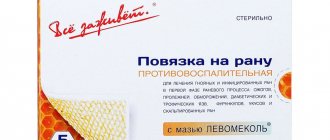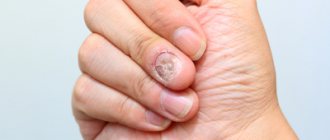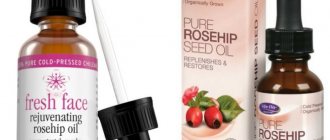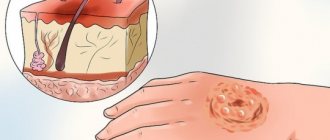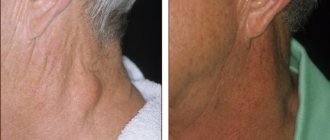Any punctured, chopped, torn or cut wound can be complicated by the process of suppuration. Even if you cut your finger with a knife in the kitchen, you should not think that this is a trifle, because an insufficiently treated wound can fester. Everyone should know the first symptoms of wound suppuration for the reason that in most cases this problem has to be solved exclusively by surgery.
This problem is especially relevant for those who have undergone any surgery and were discharged home after rehabilitation. If postoperative sutures are not cared for at home as prescribed by the doctor, then if an infection occurs, suppuration may begin. Contrary to the generally accepted opinion of patients, suppuration after operations begins not because of the conditions during the operation, but precisely due to the fault of patients who irresponsibly approach the doctor’s prescriptions when they find themselves at home.
During surgery, it is essential to maintain absolute sterility, and this principle is never violated. Medical doctors recommend that you always fully follow the prescriptions they make to avoid such serious complications.
How does the process of wound suppuration develop?
Typically, suppuration begins when a clean wound becomes infected, swelling around the wound develops, tissue necrosis and purulent discharge appear. If redness begins around the wound, which is accompanied by a tugging pain that gets worse at night, then this means that you are dealing with the first symptom of wound suppuration, and urgent measures need to be taken.
When examining the wound, dead tissue and pus are visible. The situation is dangerous because the decay products are absorbed by the body, and this leads to increasing intoxication of the body. As a result, the following symptoms appear:
- significant increase in temperature;
- chills;
- headache;
- weakness;
- nausea.
Causes of wound suppuration
Any wound, small or large, is considered infected because bacteria will get into it anyway. However, this does not always lead to suppuration. In order for this destructive tissue process to develop, additional conditions are required:
- sufficient tissue damage;
- the presence of non-viable tissue in the wound cavity;
- the presence of foreign bodies in the wound cavity;
- the presence of bleeding blood in the wound cavity;
- high concentration of pathogenic microorganisms.
Therefore, the first symptoms of wound suppuration can appear even after an ordinary splinter, provided that a piece of it remains in the body tissue, and at the same time there are pathogenic microorganisms on the foreign body itself. The latter include those that are responsible for the development of the purulent process: staphylococci, streptococci, E. coli and similar microorganisms.
In addition, there is a high risk of suppuration when the patient has a history of diabetes mellitus, vascular and somatic diseases, excess weight and old age.
The nature of the wound also matters for the development of this process. Thus, a puncture wound can fester due to the wound channel being too narrow and due to which there is no normal outflow. In the case where the wound is accompanied by crushing of surrounding tissues, suppuration occurs due to too much dead tissue in the wound and excessive contamination. At the same time, wounds on the head and neck heal faster and better, and worst of all – on the feet.
Dressings for effective treatment of infected wounds
How to understand that a wound is infected
An infected wound differs from others in appearance.
Around it and in it there are so-called signs of inflammation: redness, local increase in temperature (the skin around the wound is hot to the touch), edema (swelling around the wound) and pain. Often, pus (turbid fluid consisting of lymph, remains of dead cells, bacteria and white blood cells) is released from the wound. All these symptoms, including pain, are not enemies, but helpers. Taking medications to relieve symptoms is only possible with complex treatment along with wound treatment products. Symptoms indicate that the body is fighting the infection and trying to clean the wound. By removing them, you will not help, but on the contrary, you can slow down the processes leading to healing. In this case, it is best to focus your efforts on fighting the infection. And here, everyone has to decide: whether to see a doctor or treat the wound themselves at home. If you are treating a wound at home, you need to make a choice about what to use:
"grandmother's methods", for example, plantain, or modern dressings and means for treating purulent wounds
Of course, medical supervision is very important in many cases, since (and we talked about this above) the presence of such wounds can be dangerous, and if you do not have sufficient experience, then you may underestimate the seriousness of the situation (!). The doctor will evaluate whether the infected wound can be treated at home, and, if so, will prescribe antibiotics to suppress the growth of bacteria in the wound, and bandages soaked in various medications, including hormonal drugs. Wounds have been treated this way for many years, but a problem may arise here: such treatment may not have the desired effect. We consume a lot of antibiotics in our food. No matter what food you eat (unless you grow it yourself), you will inevitably consume antibiotics that were introduced into it when it was grown and/or prepared. Therefore, bacteria that entered the wound from our skin, in most cases, have already become resistant to antibiotics. In this case, it will be difficult even for doctors to cure a purulent wound filled with such microorganisms that are resistant to drugs. Therefore, in order to definitely cure the wound, we recommend using MODERN wound treatment products together with antibiotic therapy. When we say the word “modern,” we mean high-quality, highly effective therapeutic dressings that can influence the course of the wound process, give our cells what they need, or remove from the wound what interferes with their development.
Antiseptic dressings
Until the wound is cleaned, it will not heal. When you begin to treat a purulent wound, first try to clear it of suppuration using chlorhexidine or hydrogen peroxide; only then can you apply medicinal bandages.
By the way, “grandmother’s methods” of treatment: You or your grandmothers have probably ever placed a silver spoon in water. This was done to destroy microorganisms in this water. Water saturated with silver ions contains fewer living bacteria.
Is it possible to neutralize a large number of microorganisms in an infected wound with such water? Unfortunately no. Although silver ions are capable of destroying the most dangerous bacteria, there are few of them in such water, and there will be practically no effect. If the concentration of silver ions is increased, the result will be amazing! At the moment there are many dressings with silver ions. Take, for example, the FIBROTUL AG
. Silver ions are found in large quantities and can suppress the growth of microorganisms in the wound. This bandage is used to treat:
- dry infected wounds (dry, reddened, hot, painful wound);
- wounds with a small amount of fluid (exudate)
and to prevent infection of clean wounds.
Cleansing from microorganisms, FIBROTUL AG (Fibretulle)
will not stick to the wound.
For this purpose, it is specially impregnated with soft paraffin; in addition, it contains a lot of gel, which will transfer the moisture necessary for healing to begin. You can secure the bandage with a regular bandage, or you can use a special medical film (not every film can be applied to a wound) such as Opsite Flexigrid or IV3000 (I.V. 3000). The bandage gets a little wet because of the gel, but the film bandage will retain all the necessary moisture in the wound, and like a bandage will provide access to oxygen (this is the uniqueness of the Reactic medical film). After 2 days, the FIBROTUL AG bandage must be replaced. Based on the condition of the wound, you will see whether the same bandage needs to be applied. If the wound is no longer inflamed (infected) and has begun to heal, then further use of antiseptic dressings may be useful as an additional means of preventing infection. There is a bandage called Bactigras, which is similar in action to FIBROTUL AG, but it does not contain silver, but chlorhexidine. Like FIBROTUL AG (Fibrotulle), it can be used on dry, infected wounds, but it is also the best dressing for the complex treatment of wounds with profuse discharge. It is a coarse mesh (by the way, also impregnated with soft paraffin so as not to stick to the wound), and it can be used as a spacer between the wound and other dressings. Chlorhexidine will be released from the mesh and inhibit the growth of bacteria in the wound, and excess fluid from the wound (exudate) will pass through the mesh into the absorbent dressing. As an absorbent, you can use both gauze and other dressings, for example, Melolin
.
If you want complete convenience, then take a ready-made bandage with an absorbent Primapor
.
Its edges will easily stick to the healthy skin around the wound, and you will not need to think about additional fixation, as is the case with the Bactigras
.
The most powerful dressing against infection - “Aktikot with silver”
It happens that a wound requires a particularly strong disinfectant. They say that you don’t shoot sparrows with a cannon, but sometimes you just need a “Cannon”. So, today on our Russian market of medical goods there are unique dressings of the Aktikot family. Their bactericidal effect is so powerful and long-lasting that it allows you to cope with almost any infection in the wound. Aktikot dressings with silver nanocrystals have no equal, because they contain not just silver ions, but the source of these ions is silver itself, in the form of nanocrystals (microparticles). A powerful flow of ions from them is capable of providing a CONTINUOUS bactericidal effect in the wound for 3 days (Aktikot) and 7 days (Aktikot-7). These few days will be enough to completely clear the wound of infection. Moreover, microorganisms do not become resistant to silver, so the effect is always excellent.
Rules for applying Aktikot dressings
- Wash the wound with chlorhexidine or hydrogen peroxide.
- Remove the Aktikot or Aktikot-7 bandage from the individual packaging and place it on the wound (either side).
- Now you need to make sure that the bandage is sufficiently moistened. The fact is that for silver ions to escape from nanocrystals, a humid environment is required
. That is, AKTIKOT DOES NOT WORK IN A DRY CONDITION! There can be 2 options: either the wound itself is wet and leaks (then you can put a bandage with an absorbent pad like Melolin or a ready-made Primapore dressing on the Aktikot), or the wound is not wet enough and then the Aktikot needs to be moistened. - IMPORTANT:
Aktikot should be moistened with sterile water, but in no case with saline. solution (not sodium chloride), or you will ruin the dressing and it will not work. - Cover the moistened bandage, if there is no abundantly separated liquid, with a film bandage such as Opsite Flexigrid (Opsite Flexigrid - a special film) or Opsite Post Op (Opsite Post Op - film bandage with an absorbent pad, in case of exudate).
- Aktikot
and
Aktikot-7
can remain on the wound without replacement for up to 3 and 7 days, continuously cleaning the wound.
Victory over infection is the first, but most important victory in the treatment of infected wounds. You will see the result: the body has stopped sounding the alarm, the skin around the wound is no longer red, and all the signs of inflammation that we described above have disappeared. Healing the wound will still take time, but the wound is no longer infected and it will now be easier for the body to restore damaged tissue.
Go to the catalog - buy a bandage against infection
Chronic wounds (non-healing wounds) and their treatment
Some wounds appear quickly (for example, a surgeon, while performing an operation, cuts the skin - this is an acute wound; a dog bite - an acute wound, etc.), and some gradually and then do not heal for a long time. Such wounds are called chronic.
The reason for the appearance of chronic wounds is a violation of tissue nutrition (i.e., trophism), for example, wounds with diabetes mellitus or other conditions associated with impaired blood microcirculation in the tissues. The very appearance of such long-term non-healing wounds shows that the body needs help; it most likely will not be able to cope with them on its own. Tasks such as treating purulent, non-healing wounds in diabetes mellitus or treating venous ulcers are not easy, but if you use modern means for treating wounds, then it becomes possible to cope with them almost always.
Imagine a railway along which food trains constantly run, supplying city residents with everything they need. As long as supplies are regular, the city lives and prospers, but if supplies are reduced several times, famine will begin in the city. The same thing applies to cell nutrition: if the vessels are not able to pass through themselves a sufficient amount of blood rich in nutrients and oxygen, then the cells will first begin to starve and then die. In place of once living, healthy tissue, a field of dead cells (necrosis) appears, which are not only useless, but also harmful to the body. These dead cells are not interconnected in the same way as living ones; they are destroyed, becoming a breeding ground for microorganisms and, as a result, a constant source of infection.
As long as there is dead tissue in the wound, it will not heal. Dead cells no longer perform their functions, but take up space, interfering with the development of living tissue. Cleansing a wound from necrosis is a difficult task for the body, often overwhelming, it needs help. Thus, removing necrosis from the wound is your first priority.
Cleansing the wound from necrosis
First: wash the wound with Chlorhexidine solution; Second: take the Intrasite Gel gel bandage (Intrasite gel)
or
Intrasite Conformable
(Intrasite Conformable) and apply it to areas of necrosis (can be either black or other colors, not red, like living tissue).
The gel must be applied in a thick layer. Then you need to try to seal the wound tightly. This can be done with film dressings. Here again, we draw your attention to the fact that it is not possible to cover the wound with just any film
.
The fact is that fluid is constantly evaporating in and around the wound. If this fluid has nowhere to go, then because of it the condition of the wound may, on the contrary, worsen, since a phenomenon called “maceration” will occur (living tissues become fibered under the influence of the fluid and new cells die). We recommend that you cover the wound with the patented unique “breathable” and vapor-permeable film REACTIK, especially since oxygen must enter the wound. No other film will give him such good access of oxygen to the wound. So, take an IV 3000 bandage (I.V. 3000)
large enough to cover the wound or
Opsite Flexigrid
. Apply it by gluing it around the perimeter to healthy areas of the skin. You don’t have to worry about the gel under the bandage; it won’t spread, as it has a special viscous structure; it will remain in the places where you applied it. Leave this compress for 2, maximum 3 days. You will see that the liquid under the bandage has become cloudy. This is good, the gel dissolves dead tissue, cleaning the wound. After removing the bandage after a couple of days, you will see that the bottom of the wound has cleared. You can rinse the wound again with Chlorhexidine solution and move on to the next stage of treatment: fighting the infection. We wrote about this stage above (link).
With your help, the body was freed from dead tissue and infection in the wound. Now nothing prevents living cells from starting to divide and replenish tissue deficits. To do this, they don’t need much: a sufficient (but not excessive) amount of moisture and nutrients. Wounds that are “totally dry” heal very poorly or not at all. By creating the necessary moist environment, you will give the cells the water they need to support their growth. This can be done with the same Intrasite Gel, which we wrote about above (its important ability is to provide the necessary amount of moisture to the wound without “flooding” the cells), but since living cells at the bottom of the wound themselves have moisture, it is usually enough to simply cover with the same film dressings IV3000 or Opsite Flexigrid. They will act as a greenhouse and will not allow the cells to dry out, and there will also be enough moisture under the bandage for newly formed cells. In addition (and this is very important!), film dressings are impermeable to microorganisms and therefore will protect the wound from their penetration from the outside.
Negative pressure treatment
As you already know, the source of nutrients in tissues is our blood. The task of capillaries (the thinnest vessels) is to bring “food” and “building material” to all, even the most distant, cells of our body. For a wound to heal, a new capillary network must begin to form in it. What about the edges of the wound? How good is their blood circulation? Will the existing vessels be able to pass through enough blood to nourish the new, rapidly growing tissue? For a young and relatively healthy body, this is not a problem, but with age and due to certain diseases (such as diabetes), the blood flow in the vessels slows down. Moreover, swelling (slight swelling is present in any wounds) of the tissues puts pressure on the vessels and the lumen in them narrows, therefore, it is even more difficult for blood to pass through such a vessel. But if you dilate the vessels, blood will again circulate freely in the tissues and bring everything necessary for the appearance of new cells.
Pico is an innovative system for creating negative pressure in a wound at home.
A little clarification about negative pressure. As mentioned above, in the tissues surrounding the wound, there is usually excess fluid, which is both the cause and consequence of deterioration in blood microcirculation. Now imagine a vacuum cleaner. It sucks in everything that lies on the surface. Here is a Pico bandage, when applied to a wound, it absorbs everything unnecessary and draws out excess fluid from the surrounding tissues, thus reducing swelling. After the swelling has “gone”, the nutrient-rich blood, due to the “suction” effect, has the opportunity to squeeze closer to the edges of the wound and nourish previously starved cells. In turn, the saturated cells begin to rapidly grow and divide, filling the wound. The wound begins to shrink and heal. Most "non-heals" heal when exposed to negative pressure. Not every level of negative pressure will help heal a wound, and this is especially important to consider when treating diabetic wounds. But the PICO system creates and maintains exactly what is necessary, creates exactly the required level (-80 mm Hg), which helps improve the condition of any wound. It’s also convenient that the system weighs only 84 grams.
Now about how the Pico system works
Without going into details about the device, let's say that this unique device consists of 3 parts: a bandage to close and seal the wound, a compressor that should create negative pressure and a tube that connects them (the bandage and the compressor). There is only 1 button on the compressor. Press it after the bandage is applied and everything is connected, the compressor immediately begins to draw air and exudate from the wound, and with it the microorganisms located at the bottom of the wound. In addition, the edges of the wound are attracted to each other (this is another important effect of negative pressure in the wound), which will help it heal faster. The dressing should be applied so that the absorbent pad completely covers the wound. Depending on the position of the patient’s body, the tube suitable for the bandage (port) should be located on top so that the liquid that will be pumped out from the wound does not get into the compressor. The film on the bandage is “breathable” and vapor-permeable, so it is important to try not to block air access to the bandage (do not cover it tightly). After 1-3 days, the bandage will be filled with exudate from the wound and should be replaced with the second bandage included in the kit. Do not allow the dressing in the area of the tube to stain (this is not difficult if the tube is located on top of the edge of the wound) so as not to flood the compressor. The fact is that PICO is a unique container-free system, and the role of the jar into which the liquid flows is performed by the dressing itself. The second dressing can be used until the end of wound treatment (under the influence of the PICO device, treatment usually lasts up to 7 days). If everything was done correctly, the PICO Device will do its job and the wound will heal quickly.
Summarizing:
As you can see, modern remedies will help cure infected wounds, purulent wounds, including those with diabetes. If in doubt, call.
Keep in mind that all medicinal products, including medicinal dressings, have contraindications, and their correct selection is important for a good result. Go to the catalog - buy a bandage against infection
